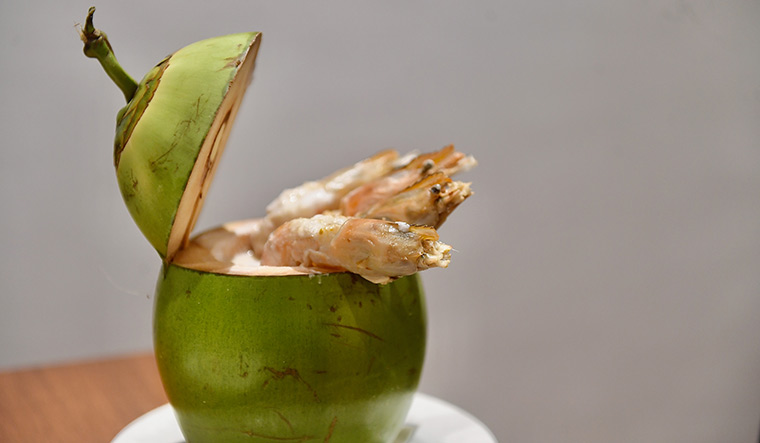BENGAL/ Dab chingri
IMAGINE AN AERIAL view of a few people stuck in a water barrel. That is how the Bengali dish dab chingri—a tender coconut filled with five or six giant river prawns—looks. And there is an authentic way of eating it, too. You fork out the prawns one by one and place them on the plate, dripping mustard gravy and all. You then fill your plate with rice. Beware of using fried rice or pulao. Go for an authentic Bengali rice like Tulaipanji, Kalonunia, Gobindobhog, Bashkhati or Dudheswar. The rice will be suffused with the flavour of coconut water, the mustard will make it smoky and the fresh prawns (known as chingri in Bengali and Odiya) will give it a slight sweetness.
You scout the coconut for more and when your fork fails, you use your fingers to dig out the remaining prawns. When done, you lick your fingers slathered in the mustard-coconut-poppy seed gravy. Embarrassed? Look around you. You will find everyone else eating their dab chingri this way, too. So give yourself up, heart and soul, to eating this most delicious dish in the right manner.
Tradition says that dab chingri was invented around 150 years ago. Many Bengali recipes are derived from British, Portuguese, French and Mughal cuisine. But chances are that dab chingri did not come from them, because Kerala and Goa, too, had a sizable Portuguese population, and this dish is not found in these coastal states. “I think it is a pure Bengali dish,” says Avik Mitra, a renowned Bengali chef who has worked in many luxury hotels in Goa and Kerala. “During my study of Bengali dishes, I have found dab chingri on the menus of the Tagore family. They always used to have authentic local dishes and Rabindranath used to make many of them. Dab chingri is one of them.”
Dab chingri might also have had its origin in feudal Bengal, where poor people could not eat prawn openly. So they placed it in coconuts and cooked the dish in ovens. Dab chingri, therefore, is a unique dish celebrating a regional technique borne out of socio-economic conditions.
“For me coconut and prawns share a special bond, and there is nothing better than a mouth-watering plate of dab chingri [to bring it out]. It is actually a celebration of richness, diversity and tradition in Bengal, combining the western and eastern traditions on both its sides [of Bangladesh and West Bengal],” says Subhojit Roy, honorary secretary of the Eastern Chamber of Commerce.
A specialist and an old hand at making dab chingri, Mitra explains why it is an exclusively Bengali dish. “Unlike in the southern and northern parts of India, Bengali gravy is heavy. In dab chingri, we bring the tender coconut out of the shell. We marinate it with giant prawns, mustard and crushed poppy seeds along with mustard oil. It is then baked in an oven,” says Mitra. Then it is mixed with tender coconut water and stuffed inside the coconut till it gets absorbed. It is then wrapped in silver foil for a few minutes.
But Mitra warns, “What makes Bengali cooking special is that everything has to be used in optimal quantity. Nothing more and nothing less. If not, all will be messed up and it will not be a pure Bengali dish. You cannot do all this at home, and that is why Bengalis have this dish in restaurants.


